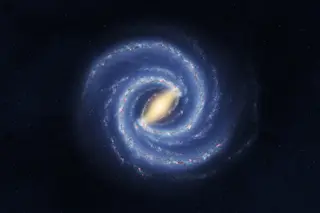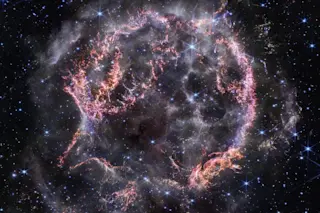Two years ago, nasa’s Marshall Space Flight Center in Huntsville, Alabama, hosted a conference on the astronomical phenomenon known as gamma-ray bursts. Plenty of observational astronomers showed up, but, says Gerald Fishman, a Marshall astrophysicist, the theorists mostly stayed away. It wasn’t for lack of interest: since their discovery in the late 1960s, these brief flashes of high-energy electromagnetic radiation have been one of the enduring mysteries of astrophysics. Explaining them would qualify as a major coup.
The trouble was, nobody could figure out where the gamma-ray bursts were—in and around our Milky Way galaxy or at the far reaches of the universe. That put the theorists in the position of trying to explain something that might be either a distant mountain or a nearby molehill. No wonder they didn’t make the trip. Things were rather muddled, admits Fishman.
Cosmologists spend most of their time brooding on the beginning of the universe, but astronomer Fred Adams of the University of Michigan at Ann Arbor decided to calculate the future as precisely as standard cosmology and physics will allow. Last January, Adams and his colleague Greg Laughlin reported that the kind of universe we know—one dominated by bright stars and galaxies—is just a cosmic blip, albeit one that will last some 100 trillion years. By then, even the longest-lived stars will have burned out, and the universe will consist of black holes, dark brown dwarfs, and ever-cooling white dwarfs. That will not be the end, though. Dwarf stars, like all ordinary matter, are made of protons—which particle physicists believe last for only 1038 years or so. (That’s 1 with 38 zeros.) If so, all the dwarf stars and all their protons will fall apart by 1040 years from now. There will still be black holes—but black holes are thought to evaporate. Although the process is slow—very slow—by 10100 years from now, there should be nothing left but a smattering of electrons, positrons, neutrinos, and photons skittering across space. What will this ultimate Dark Age be like? The universe doesn’t end, and complex physical processes don’t end, Adams says. We’re more limited by our lack of imagination in thinking this far into the future than we are by a deficit of interesting physical processes.














